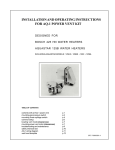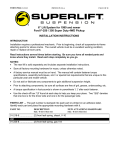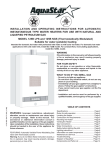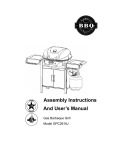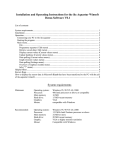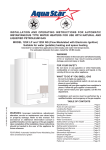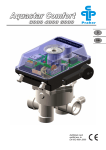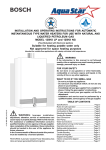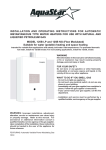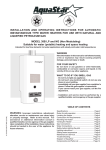Download AquaStar 170 VP Operating instructions
Transcript
INSTALLATION AND OPERATING INSTRUCTIONS FOR AQ-1 AND AQ-2 POWER VENT KITS AQ-1: DESIGNED FOR AQUASTAR 125X & 125B MODELS AQ-2: DESIGNED FOR AQUASTAR 170VP MODELS TABLE OF CONTENTS contents with an AQ-1 or AQ-2 powervent mounting gas pressure switch mounting linear spillage switch common setups locating vent hood (clearances) mounting power vent motor (clearances) troubleshooting and maintenance safety test AQ-1 wiring diagram AQ-2 wiring diagram vent hood template p.1 p.2 p.4 p.6 p.7 p.7 p.9 p.10 p.11 p.12 p.13 8504077 rev.1 AQ-1 Power vent kit for Aquastar 125X & AQ-2 Power vent kit for Aquastar 170vp 125B models. Parts included Parts included Spillage Switch Kit Spillage Switch Kit 1. 1. 2. 3. 185º F linear spillage switch mounted on an angled bracket and equipped with 36 inch cables connected to one eyelet terminal and one 1/4" quick connect terminal Spillage switch mounting screw Push on male spade connector, replaces eyelet terminal from 36 inch spill switch cable. 2. 3. 185º F linear spillage switch mounted on an angled bracket and equipped with 36 inch cables connected to one eyelet terminal and one 1/4" quick connect terminal Spillage switch mounting screws (2) Capillary tube offset clips with mounting screw 3 ea. Vent Hood Kit Vent Hood Kit 1. 2. 3. 4. 1. 2. 3. 4" vent hood: VH1-4 Plastic wall anchors (4) Sheet metal screws (4) 5" to 4" vent reducer pipe 4" vent hood: VH1-4 Plastic wall anchors (4) Sheet metal screws (4) Vibration Mount Packet Vibration Mount Packet 1. 2. 1. 2. Vibration mounts (2) with nuts and washers Brackets (2) with nuts and washers Vibration mounts (2) with nuts and washers Brackets (2) with nuts and washers Gas Pressure Switch Packet Gas Pressure Switch Packet 1. 2. 3. 1. 2. 3. 4. Gas pressure switch Self-tapping mounting screws (4) Manifold pressure tap fitting with 1/4" compression nut and sleeve 1/4" by 40" aluminum tubing (2) 4. Gas pressure switch Self-tapping mounting screws (4) 1/8" NPT male by 1/4" compression fitting with 1/4" compression nut and sleeve 1/4" by 40" aluminum tubing (2) Power Vent Kit Power Vent Kit 1. 1. 2. Power venter (HSUL-1 Series containing integrated 24v control circuit) including 25 foot control cable with 1/4" quick connect ends and an HPN 6 foot power cord Nylon ties 2. 1 Power venter (HST-1 Series containing integrated 24v control circuit and post purge timer) including 25 foot control cable with 1/4" quick connect ends and an HPN 6 foot power cord Nylon ties Before beginning installation review required clearances for Aquastar, Power Vent Motor and Vent Hood FREEZING CONCERNS TO AQUASTAR: The vent hood and power vent will not prevent infiltration of cold air to the Aquastar when not in use. Be sure to correct any causes of negative air pressure in room. If this is difficult add additional horizontal lengths of 4" vent pipe between power vent and the Aquastar to warm any infiltrating air. Power Vent Kit CAUTION 1. 2. Failure to install, maintain and/or operate the Power Venter in accordance with manufacturer's instruction may result in conditions which can produce bodily injury and property damage. Gas Pressure Switch The Power Venter must be installed by a qualified installer in accordance with all local codes or, in their absence, in accordance with the National Fuel Gas Code (ANSI Z223.1NFPA #54), the National Electric Code and The Occupational Health and Safety Act (OSHA) as applicable. 3. The Power venter motor shaft must be mounted horizontally to prevent motor bearing wear. 4. Disconnect power supply when making wiring connections or when working around the fan blade and motor. Failure to do so may result in severe personal injury and equipment damage. 5. Make certain the power source is adequate for the fan motor requirements. Do not add the power venter to a circuit where the total load is unknown. Remove the gas pressure switch from the carton. Also remove the brass fittings (170vp: 1/8" NPT by 1/4"compression fitting and nut), (125X/B models: manifold pressure tap fitting and 1/4" compression nut). The four self-tapping screws and the two sections of 1/4" diameter aluminum tubing from the master carton. The gas pressure switch is to be mounted in such a way that the diaphragm is oriented vertically and the aluminum tubing pieces can easily reach the manifold pressure test nipple and the burner respectively. It must not be mounted inside the heater. See p.6 When mounting to an Aquastar 170vp: We recommend mounting on the lower right side of the Aquastar. Both sides of the switch bracket can screw into the side panel. Installed in this manner all necessary connections will be well within reach and there should be minimal interference when servicing. The four screws provided are self-tapping. Their 1/2" length assure that components inside the Aquastar will not be damaged upon penetration. You must not mount the switch where the screws could penetrate the heat exchanger tubing inside the Aquastar. Aquastar 1. Follow installation and operating instructions manual supplied with the Aquastar. 2. Before mounting water heater to wall, check its minimum clearance requirements. 3. When using an AQ-1 or AQ-2 the maximum horizontal distance from Aquastar to discharge is 100 feet. Subtract 10 feet for each added elbow. Install power venter motor as close to the termination as possible to maintain the Aquastar's optimal efficiency. When mounting to Aquastar 125X/B models: We recommend mounting the gas pressure switch vertically against a wall on the lower left side of Aquastar 125X/B models. Because the cabinet cover is three sided we do not recommend screwing the gas pressure switch to the left side of it. Instead, mount the gas pressure switch vertically against a wall on the lower left side of Aquastar 125X/B models. Installed in this manner all necessary connections will be within reach and there will be minimal interference when servicing. See p.6 2 ROUTE TUBING TO PRESSURE 125X/B MODELS TAP PORT ON THE AQUASTAR BURNER MANIFOLD ROUTE TUBING TO BURNER AREA OR ATMOSPHERIC VENT MANIFOLD TAP FIGURE A FIGURE B PRESSURE TAP-GAUGE PORT (WHERE AQUASTAR MANIFOLD PRESSURE CAN BE MEASURED) 170VP MODEL MANIFOLD TAP INSTRUCTIONS (SEE DIAGRAMS ABOVE) 1. Mount gas pressure switch by securing it to the chosen location with a screw in each one of the four mounting holes. 2. Use a tube cutter to make a clean cut (not crimped) at each end of the two lengths of the 1/4" aluminum tubing. One tube must be long enough to reach from the fitting marked "connect to gas valve" to the pressure tap port on the Aquastar burner manifold (Not to the inlet gas pressure port of the Aquastar since there will be constant gas pressure there). The second tube must be long enough to reach from the gas pressure switch to the burner near (but not in) the pilot flame area. Allow enough slack for very gradual bends. (See Figure A). 3. b. On Aquastar 170vp model the pressure tap fitting has a brass hex cap. Separate the pressure tap fitting from the hex cap with two wrenches. See Figure B. Save the pressure tap fitting. c. Bend the 1/4" aluminum tubing so that it runs to where the fitting attaches to the manifold. Make gradual bends - do not crimp the tube. d. On model Aquastar 170vp assemble the 1/8" NPT male by 1/4" compression fitting with nut and sleeve to aluminum tube. Tighten with two wrenches. Do the same thing for Aquastar 125X/B models with provided pressure tap fitting and 1/4" compression nut with sleeve. ATTENTION - Failure to follow the next series of instructions may result in breaking a part. e. Separate the joint just made in step 3.d. On Aquastar 170vp models connect the 1/8" NPT male by 1/4" compression fitting to manifold pressure tap fitting as removed in step 3.a. Use an appropriate thread sealant. Snug up this joint while it is off the heater. a. Remove the brass pressure tap fitting from the burner manifold of the Aquastar. Observe the end of the fitting that screws into the manifold, notice that it is brass (soft metal). See Figure B. This fitting will not be required for reuse on 125X/B models. 3 f. Hand thread the pressure tap fitting (125X/B) or pressure tap fitting assembly (170vp) into the Aquastar manifold. Use a small amount of an appropriate thread sealant for Aquastar 125X/B models. Aquastar 170vp model has a flat washer that makes the seal for this joint so excessive tightening is not necessary. Over tightening will break the pressure tap fitting. g. Guide the end of the tube into the compression fitting. While using one wrench to hold back the pressure tap fitting, gently snugup the compression nut with a second wrench. 4. Bend the second piece of aluminum tubing (from step 2) so that it will reach from the gas pressure switch through the underneath of the Aquastar to an area near the pilot head. Connect one end of the tube to the fitting marked "warning" on the gas pressure switch. The other end of the tubing should now extend to burner area close to pilot. This tube should not discharge into the flame nor should it extend above the upper edge of the burners. This tube vents gas to the combustion chamber for ignition in case of a diaphragm failure in the gas pressure switch. 2. On Aquastar 170vp model the linear spill switch should mount in a location where the tube can extend across the front of the draft diverter while allowing the switch cables to easily reach the overheat temperature sensor (ECO) connections. (See Figure C) On Aquastar 125X/B models the linear spill switch should mount in a location where the tube can extend across the top of the draft diverters while allowing the switch cables to reach the ECO. (See Figure D) 3. Route the cables to the ECO switch inside the Aquastar keeping the cables out of contact with hot surfaces. SAFETY CIRCUIT The linear spill switch, when wired in series with the Thermocouple and ECO of the Aquastar, form the Safety Circuit. Aquastars have been manufactured with differing ECO locations. Depending on where the ECO is in your Aquastar, you will need to follow slightly different instructions for making the connections. 1. NOTE: The gas pressure switch has a built in pressure tap marked "gauge port". Use this tap instead of the Aquastar manifold tap when checking manifold pressure. (See Figure A) On Aquastar 170vp models two ECO's are mounted on the left side of the heater, upper one is black and lower one is white. (See Figure C) a. Remove and discard heavy gauge wire from both upper and lower ECO's and attach one linear spill switch cable to upper ECO terminal and one to lower ECO. Linear Spillage Sensing Switch Note: remove the one 1/4" quick connect terminal and affix an eyelet terminal (not provided) to make a secure connection at either ECO that this cable is connecting to. This switch provides a means for safety shut down of the Aquastar in the event of flue blockage or power venter failure. If hot flue gasses spill from the draft diverter, the draft spillage sensing switch will open the pilot safety circuit and shut off all gas to the Aquastar. The switch is normally closed and opens at temperatures greater than 185º F. It has a manual reset button. On Aquastar model 170vp the copper capillary sensing tube should be attached across the front panel above its large opening with the offset clips provided. See setup diagram on page 6. INSTRUCTIONS 1. The entire length of the copper capillary sensing tube is heat sensitive. The idea is to suspend the tube within close proximity of the Aquastar's draft diverter. Offset clips are provided for this purpose on model 170vp, not needed on 125X/B models. Note: do not cut the copper capillary sensing tube. 4 CONNECT THIS SPILL SWITCH FIGURE C LEAD TO ECO TERMINAL BY PUSHING IT ON OR CUTTING AND REPLACING ITS END WITH AN EYELET TERMINAL. Aquastar 170vp Model REMOVE HEAVY GAUGE WIRE FROM UPPER AND LOWER ECO TERMINALS. CONNECT SPILL SWITCH LEAD TO ECO TERMINAL 3. On Aquastar 125X/B models the ECO is mounted on the lower left outlet water pipe. (See figure D) FIGURE D a. Remove one lead connecting to ECO terminal, it does not matter which one is disconnected. b. Attach 1/4" quick connect terminal end of linear spill switch cable to now exposed terminal of the ECO. c. Remove the eyelet ended terminal from the other spill switch cable. Affix the push on male spade connector, which is provided with the AQ1, to this spill switch cable. d. Connect this male spade connector to the removed lead wire from step 3.a. 125X/B Models ECO DISCONNECT EITHER WIRE FROM ECO. PUSH ON ONE SPILL SWITCH LEAD CABLE TO ECO AND OTHER (RETROFIT FIRST) INTO EITHER WIRE THAT WAS REMOVED. On Aquastar 125X/B models the linear spill switch should be attached to the upper right-hand side on the draft hood diverter (see figure E). There are two holes provided for attachment on this diverter and only the front most hole should need to be used. With the #12 self tapping sheet metal screw securely mount the spill switch bracket to the diverter. For ease of access position it so the reset button faces outward and then bend the bracket so the switch can stand vertically. FIGURE E CAPILLARY SENSING TUBE RESET BUTTON SPILL SWITCH CABLES The copper capillary sensing tube should then be directed to the left by looping it over the diverter opening, up in front of the 5" diameter vent pipe and then down across the upper left hand draft diverter. 5 COMMON SETUPS Aquastar 170vp Model Location of Linear Spillage Switch (Route Spillage Switch Cables behind back) 125X & 125B Models Mount gas pressure switch against wall See Figure E for location of Linear Spillage Switch 6 NOTE: FOLLOW REQUIREMENTS IN FIGURES F & G ON THIS PAGE BEFORE INSTALLING VENT HOOD, THEN USE TEMPLATE ON PAGE 13 TO CUT HOLE. "The exit terminals of mechanical vent system shall be located not less than 7 feet above grade when located adjacent to a public walkway. The venting system shall terminate at least 3 feet above any forced air inlet within 10 feet. The venting system shall terminate at least 4 feet below, 4 feet horizontally from or 1 foot above any door, window or gravity air inlet into any building." Also, "The vent terminal shall also not be installed closer than 3 feet from the inside corner of an L-shaped structure, or less than 1 foot above grade." CAUTION Failure to follow these installation instructions may violate applicable national and/or local codes The vent system must terminate so that proper clearances are maintained as cited in the National Fuel Gas Code, ANSI Z223.1 FIGURE F POWER VENT FAN AND MOTOR 2. Power venter must be mounted with motor shaft horizontal to prevent motor bearing wear. 3. Power venter housing is single walled. A 6" clearance from combustible material must be maintained. (See Figure G) 4. Whenever possible, allow for a minimum of 12" vertical rise off the top of the Aquastar before the vent piping makes a 90º elbow to the horizontal. Observing this guideline will help prevent nuisance shut downs. Code Requirements Power vent installation must be in accordance with the following requirements of the National Fuel Gas Code: Provisions shall be made to interlock the appliance(s) to prevent the flow of gas to the main burners when the draft system is not performing so as to satisfy the operating requirements of the equipment for safe performance. FIGURE G Power venter should be installed as close to the termination of the vent system as possible to obtain optimal appliance efficiency and to prevent flue gas leakage. 7 6" v 6" v v Installation Restrictions 1. 6" v v • All portions of the vent system under positive pressure during operations (on the outlet side of the power venter) shall be designed and installed so as to prevent leakage of flue or vent gasses into building. v • INSTRUCTIONS (DO NOT BEGIN THESE PROCEDURES UNTIL VENT HOOD HAS BEEN INSTALLED) 1. Remove vibration mounts, nuts and washers from parts bag. Install on power venter as shown in (Figure H). 2. To prevent vibration, securely support power venter from ceiling or joist using a plumber's strap or wire fastened to the vibration mounts. As an alternative means of support, a wall bracket may be used to support the underside of the motor. (NOTE: Plumbers strap, wire or wall bracket must be supplied by installer.) 3. Connect the power venter outlet to the inner sleeve of the vent hood. If you need to add sections of 4" Class B vent pipe between the power venter and the vent hood, first check if it is permissable with local codes. Use the 4 prepunched holes in the outlet collar of the power venter as a guide to drill 1/8" diameter holes into the vent pipe. Fasten power venter outlet to the vent hood inlet using sheet metal screws. 4. All vent pipe connections after the power venter will be under positive pressure during operation. These connections must be sealed with high temperature silicone sealant or aluminum vent pipe tape supplied by the installer. 5. Install properly sized vent pipe connections from the power venter inlet to the Aquastar's outlet avoiding elbows, wherever possible. Allow a minimum of 12" vertical rise off the top of the Aquastar before the vent makes a 90º elbow to the horizontal. Observe the vent pipe length restrictions mentioned earlier. NOTE: The AQ-1 provides a 5" to 4" reducer vent pipe which is applicable to Aquastar 125X/B models only. The AQ-2 does not provide a 6" to 4" reducer vent pipe and must be provided by the installer. 6. Support the vent pipe in accordance with vent manufacturer's instructions. Vent pipe is not supplied in the power venter package, except for the 5" to 4" reducer vent pipe in the AQ-1. Observe the clearances associated with the class of vent pipe used. FIGURE H Installation - Electrical 8 1. Route the control cable from the power venter fan along the ceiling or joists down to the gas pressure switch, taking care not to come closer than 6" to the vent pipe or any other potentially hot surface. In many cases, the gas supply piping can be used as a routing path from the ceiling down to the controls, using the supplied nylon ties to secure the cable. 2. Connect the BLUE wire from the jacketed power vent cable onto the normally open terminal of the gas pressure switch. (See Figure I) FIGURE I 3. Connect the RED wire from the jacketed cable onto the common terminal of the gas pressure switch. (See Figure I) NOTE: If the distance between the power venter and the gas pressure switch is greater than the length of the cable, splice a section of 2 conductor, PVC sheathed, 105º C thermostat cable to the supplied cable. Make sure that the colored leads remain consistent. TROUBLE-SHOOTING, MAINTENANCE AND TEST PROCEDURES 5. Vent System Maintenance Combustion Air Test The vent system must be inspected at regular 3 month intervals. Points of inspection are as follows: 1. Close all doors and windows of the building. If the Aquastar is installed in a utility room or closet, close the entrance door to this room. Close fireplace dampers. 2. Turn on any clothes dryers. Turn on all exhaust fans, such as a range hood, bath room exhaust fans and whole house fans, to maximum speeds. (Do not turn on any fans used strictly for summer exhausting). 3. Open a hot water tap to full flow. 4. Allow all fans and the Aquastar to operate for five (5) minutes. 5. Tripping of the spillage switch circuit during the 5 minute Aquastar operation indicates an unsafe operating condition. Turn off gas supply to Aquastar and DO NOT OPERATE UNTIL UNSAFE VENTING CONDITION IS INVESTIGATED BY PROFESSIONAL CONTRACTOR OR UTILITY SERVICE PERSONNEL. 6. Return all windows, doors and fans to their previous condition of use. 1. 2. Screened opening of the vent hood should be free from foreign material and cleaned as necessary. Check all vent system connections for leakage and reseal where needed. If any vent pipe shows signs of deterioration, replace immediately and check new connections for possible leaks. Reseal using General Electrical RTV 106 Red HiTemp Silicone Sealer or equivalent. Make sure pressure switch is mounted in such a way that the diaphragm is oriented vertically. Gas Pressure Switch Test 1. Follow the Aquastar operating instructions to light the pilot. 2. Open a hot water outlet. This should energize the power vent system. Next close the hot water outlet to de-energize the venter. 3. Repeat step 2 to assure proper operation. 4. If power venter does not energize, check that the gas pressure switch tubes are properly connected and that the tube ends are not pinched closed. 9 SAFETY INTERLOCK TEST 1. Open the gas supply to the Aquastar. 2. Remove the vent pipe from the vent connector on the top of the Aquastar. 3. Block the vent connector with sheet metal or other noncombustible material. 4. Turn on the hot water supply to allow the burner to activate. Hot flue gasses will spill from the draft diverter momentarily. In less than three (3) minutes, the linear spillage switch should trip, opening the electric circuit to the electromagnet valve and halting the flow of gas to the burner. 5. CAUTION: If for any reason the system has shut down during operation, the cause of the system failure should be investigated and corrected before resetting the safety switches and lighting the pilot. NOTE: If spillage switch does not shut off the gas, check that you have made the proper safety circuit connections. If the switch still does not trip, contact Controlled Energy Corporation at 800 642 3111 or Tjernlund Products at 800 255 4208. 5. After the burners shut off, turn off hot water supply and wait 2-3 minutes...then push the reset button on the linear spillage switch. 6. Light pilot on Aquastar and repeat Safety Interlock Test, (Step 1-5) 7. Reconnect the vent pipe to the venting system when complete. If you have any questions with regard to this installation, please call Controlled Energy at 800 642 3111 or Tjernlund Products at 800 255 4208. CAUTION: Metal vent pipe and vent blockage metal will be hot. In the Event of Pilot Outage 1. Push the reset button located in the center of the linear spillage sensing switch. 2. Verify that there is 115V power provided to the Power Venter. This can be done by checking the circuit breaker and electrical connections. 3. Visually verify that all the connections of the control cord circuit are intact. 4. Follow Aquastar installation and operating instructions for relighting the Aquastar. Perform the operation circuit test and safety circuit check. (See Safety Interlock Test) 10 A Q U A S TA R S A F E TY I N T E R L O C K D I A G R A M ECO 11 A Q U A S TA R S A F E TY I N T E R L O C K D I A G R A M UPPER ECO LOWER ECO 12 1. 2. 3. Attach this template to the interior of the wall the Vent Hood will be penetrating. Ensure that proposed vent termination clearances are met before cutting opening through wall. Using a 1/2" drill bit, drill two pilot holes where noted on this template. The drill bit must be long enough to penetrate to the building exterior. Attach this template to the building exterior aligning the pilot holes on the template with 4. 5. 6. the pilot holes drilled in step 2. Using a reciprocating saw, cut a hole through the building siding, wall board, etc., following the appropriate lines of this template. Slide the vent hood through the opening and fasten to exterior wall using provided screws. Once Power Venter is completely installed and secured, apply a bead of exterior rated caulk between Vent Hood flange and exterior of building. VH1-4 (SQUARE) VENT HOOD INSTALLATION TEMPLATE CUT HOLE THROUGH WALL TEMPLATE PILOT HOLE PILOT HOLE BUILDING EXTERIOR NOTE: HARDWARE SHOWN INCLUDED WITH VENT HOOD WASHER (4) SHEET METAL SCREW (4) 13














